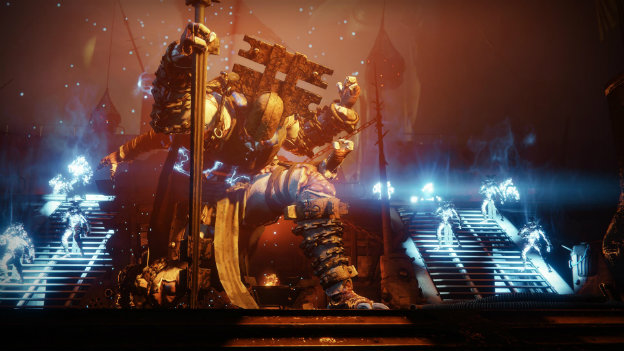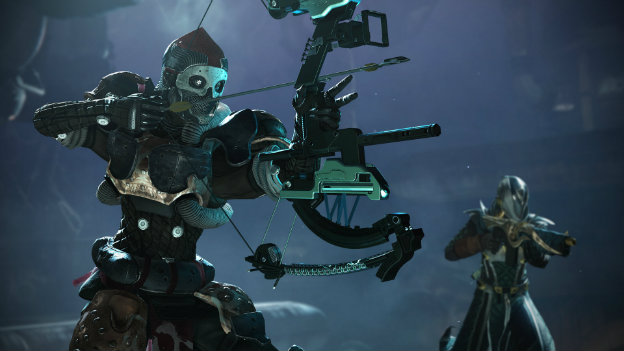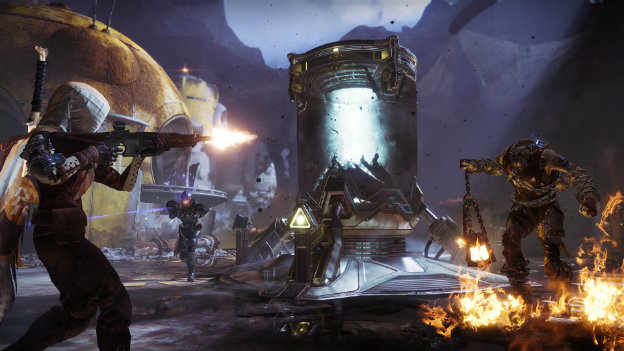Forsaken, but not Forgotten
Destiny 2 ’s path has been a bumpy one, with a fanbase that desperately wants to love the game running up against various design choices or ostensible issues that make it very angry often. But with Forsaken , the game’s latest expansion, things seem like they are about to change. It’s a kicking off point for a whole new Destiny 2 , in which the rules are different and the world is changed forever in a Marvel Comics summer event sort of way. I’m not as in the weeds as most Destiny diehards, but I have spent quite a lot of time with the game since it launched and found myself curious about Forsaken after mostly bouncing off the other expansions. After spending a big ol’ chunk of time with it, I’m not sure if I can definitively declare Destiny 2 saved and cleared of all sin, as I’m simply not equipped for that. However, I can say I found myself compelled by the new content, which is a welcome surprise in and of itself.
The Destiny 2 campaign path is an interesting one. As a sort of attempt to address complaints of the first game, the sequel actually starts with a campaign framing, introducing (or re-introducing) players to the world with a story about a very angry and very red army trying to capture the Traveler, a messianic planet-looking entity that gives the Guardians (player characters) respawn powers. Over the course of the base game’s story, you save the day, then the game implies that the tale is far from over. It may as well have been, because the previous two expansions offered some measly campaign additions that were more like bolted-on side-stories that were more about fleshing out the capital L Destiny lore, most of which is incomprehensible without diving into material outside of the game anyway.
The thing is, Destiny has a central cast of characters and Bungie really wants you to like them. They especially wanted you to like Cayde-6, a robot man voiced by Nathan Fillion who cracked a lot of jokes. But there was never enough there in the story to establish a real connection with the characters, outside of isolated moments and lots of merchandise. Forsaken attempts to rehab that, but it does so by murdering the comedic robot actor man, which is an intriguing choice to say the least. I can’t say I care more about the characters after playing through Forsaken ’s story, but I did care more about what I was doing.
See, a lot of Destiny 2 involves the player reacting to things. The evil army takes your powers away, so you have to go out and get them back. A time-travelling ex-Guardian needs your help to kill a bunch of robots. A woman appears out of nowhere, because there’s a giant worm or something. It’s all reactive. In Forsaken , there’s an extra layer of motivation in avenging Cayde-6. There’s more happening on a street level, if that makes sense. There’s a big prison break, Cayde is murdered, then the rest of the thing is about the Guardian seeking revenge while your avatar’s crew is forced to stick to politics. It’s less “I’m reacting to vague sci-fi things happening around me” and more, “I’m pursuing a goal that I want because of something that happened to me.”
Forsaken also has a really cool rogue’s gallery vibe to it, as the meat of the campaign sees you hunting down a ragtag group of ex-cons who all joined up with the Big Bad after the prison break. You spend most of your time in a brand new area in the game. It’s a bit bigger than the other planets and much more about seeking and destroying galactic scum than wandering around and tripping over treasure boxes. The whole vibe has this extra layer of cartoony grit to it that Destiny 2 didn’t have before. It’s almost, you know, cool.
Okay, now that I’ve dedicated half of this review to the story, you may be screaming at your monitor about the meat and potatoes of Forsaken , which is all the MMO-style, non-campaign content. What’s different? What’s new? What miniscule changes and tweaks were made to the experience that justifies the fanfare and yelling? To most of that I respond, “This is a review, not a patch notes document. Please give me a break. I’m tired and miss my family.” Kidding aside (help me), there is a lot to do now, which adds up to even more than there was before. There’s also some cool stuff that seems bizarre in hindsight to not have included in the first place.

For starters, Forsaken brings with it a few new additions to the regular menus. Now, for example, you can go in and actually track everything you’ve found. In a loot-based game like Destiny 2 , it’s amazing that there wasn’t already some kind of system that would allow you to look into what you’ve found, versus what you haven’t. There’s also a big list of in-game achievements you can sift through, achieve to your heart’s content, and also have a readily-available record of it all. Those are two simple, but large, quality of life adjustments that will pop out at you immediately.
Another big addition is the Gambit mode, a new type of multiplayer that’s actually a hybrid between Player vs Enemy and Player vs Player. Two teams are dropped in separate arenas and must fight their own enemies. Enemies drop motes, which can then be dropped in a bank. Collect a certain number of motes, and your boss enemy will spawn. Defeating it will award a winning point if your team takes theirs down first. Of course, teams can interfere with each other, by way of indirect actions afforded by depositing certain numbers of motes in the bank at once.

I’ve read an interview or two leading up to Forsaken , in which Bungie compares Gambit to games like Super Puzzle Fighter . I see exactly what that comparison means in playing the mode. In Super Puzzle Fighter , there are two opposing sides that are competing, but not directly attacking one another. Instead, the two sides are attacking their own boards and clearing space to protect their own skin. However, if they can hit a big clear or better yet, a combo, junk blocks will fall in their opponent’s space that block moves and make their board more dangerous.
Gambit is that gameplay concept applied to a first-person shooter. It’s really fascinating and, once you get the hang of it, works out pretty well. It’s also a great tool for bringing less hardcore players together with the more experienced fans, easing the former into competition and giving the latter something to do with a larger number of people. I can see the Destiny 2 community latching onto Gambit, assuming the rewards are worthwhile.

There’s plenty of other stuff going on in Forsaken , with some of it (such as the new Raid) not even being available yet. But I’ve already wasted plenty of your time that would better be spend tooling around the Reef and finding cool stuff. I found myself pleasantly surprised by Forsaken . I hesitantly dipped into it, but found myself jonesing for more whenever I put it down. Between the fun new story, excellent new game mode, and the buckets of new loot and equipment, I can see Destiny 2 fans having a lot less to complain about… for now.
RATING OUT OF 5 RATING DESCRIPTION 5.0 Graphics
Destiny 2 remains an incredibly good-looking game, with plenty of impressive skyboxes. 4.0 Control
Sometimes there is a bit too much going on, which can lead to fumbling. But it’s super responsive and a blast to play. 4.5 Music / Sound FX / Voice Acting
Destiny 2 is one of the few games that pulls off the big, sweeping score thing well. Lots of distinct and creative music. 5.0 Play Value
If you run out of things to do, I seriously envy the amount of free time you have. 4.5 Overall Rating – Must Buy
Not an average. See Rating legend below for a final score breakdown.
| Review Rating Legend | |||
|---|---|---|---|
| 0.1 – 1.9 = Avoid | 2.5 – 2.9 = Average | 3.5 – 3.9 = Good | 4.5 – 4.9 = Must Buy |
| 2.0 – 2.4 = Poor | 3.0 – 3.4 = Fair | 4.0 – 4.4 = Great | 5.0 = The Best |
Game Features:
